From Novel to Screen and Beyond
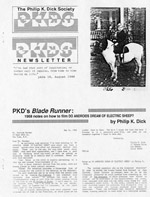 |
Philip K Dick. “PKD’s Blade Runner: 1968 Notes on How to Film Do Androids Dream of Electric Sheep?” In The Philip K. Dick Society Newsletter #18, August 1988. Glen Ellen, Calif.: The Philip K. Dick Society. [zoom] | Additional images:  
Do Androids Dream of Electric Sheep? was first optioned for a film shortly after its original release in 1968. Dick, clearly thrilled over the prospect of a big-screen interpretation of one of his works, sent a lengthy letter to prospective producer Bertram Berman with some ideas about how the film could be translated to film. He even makes some casting suggestions, including Gregory Peck for Deckard and Dean Stockwell for Jack Isidore. Despite the author’s enthusiasm, Berman’s project failed to get off the ground, and his option expired in the mid-’70s. This opened the door for aspiring screenwriter Hampton Fancher, whose take on the novel evolved into Blade Runner. It’s unlikely that the Blade Runner production team was aware of Dick’s notes, but according to producer Michael Deeley, Gregory Peck was a strong advocate of Fancher’s script. |
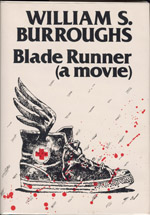 |
William S. Burroughs. The Blade Runner (A Movie). Berkeley, Calif.: Blue Wind Press, 1979. [zoom] Alan E. Nourse. The Blade Runner. Philadelphia, Penn.: David McKay, 1974. Dick’s original novel went through several titles in its various drafts, from the mundane (The Electric Toad) to the baroque (The Killers are Among Us! Cried Rick Deckard to the Special Man). The screenplay based on the novel also went through several names, including Android, Mechanismo, and Dangerous Days. The film’s producers finally settled on Blade Runner, a title borrowed from a 1979 novella by William S. Burroughs, itself an adaptation of a 1974 novel by Alan E. Nourse, a physician who specialized in medically-themed science fiction. Nourse’s novel bears no real relation to the film beyond its title. It is a medical dystopia based in a future where health care is limited to those the government deems eugenically fit. “Bladerunners” are underground medical supply smugglers who assist black market doctors in providing health care for the ineligible. |
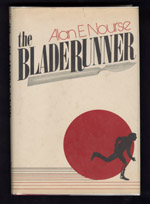 |
|
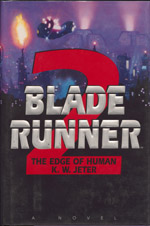 |
K. W. JETER. Blade Runner 2: The Edge of Human. New York: Bantam Books, 1995. [zoom] K. W. Jeter. Blade Runner 3: Replicant Night. New York: Bantam Books, 1996. In the aftermath of the 1992 director’s cut of Blade Runner, which cemented the film’s classic status, author K.W. Jeter wrote a series of sequels to the film. Jeter was a close friend of Dick’s in the last decade of his life, and was the basis of the character Kevin in Dick’s 1981 semi-autobiographical novel VALIS. Kevin, skeptical about the mysticism of Dick’s stand-in Horselover Fat, uses a story about a dead cat to question the existence of a benevolent deity, much like the electric animal vet Hannibal Sloat in Androids. |
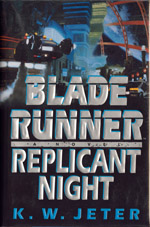 |